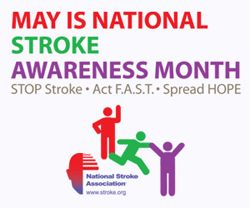Stroke is the fifth leading cause of death in this country and one of the leading causes of adult disability. According to research, however, few people know what a stroke is and how to recognize when a stroke is happening. A stroke occurs when blood flow to an area of the brain is cut off. Brain cells are deprived of oxygen and begin to die. A stroke can cause permanent loss of speech, movement and memory. May is National Stroke Awareness Month and a great time to learn more about the risk factors and symptoms of a stroke. Anyone can have a stroke regardless of age, gender or ethnicity. There are controllable risk factors as well as uncontrollable ones.
The list of controllable risk factors includes high blood pressure; atrial fibrillation; high cholesterol; diabetes; atherosclerosis; circulation problems; tobacco use and smoking; alcohol use; physical inactivity; and obesity.
Uncontrollable risks include age; gender; race; family history; previous stroke or TIA; fibromuscular dysplasia; and patent foramen ovale (hole in the heart).
Common stroke symptoms in men and women include:
- Sudden numbness or weakness of face, arm or leg – especially on one side of the body
- Sudden confusion, trouble speaking or understanding
- Sudden trouble seeing in one or both eyes
- Sudden trouble walking, dizziness, loss of balance or coordination
- Sudden severe headache with no known cause
Women sometimes report unique symptoms including:
- Sudden face and limb pain
- Sudden hiccups
- Sudden nausea
- Sudden general weakness
- Sudden chest pain
- Sudden shortness of breath
- Sudden palpitations
Immediate action is imperative because the most effective stroke treatments are available only when the stroke is diagnosed within the first three hours after symptoms begin.
The National Stroke Awareness group asks that everyone familiarizes themselves with the following symptoms:
Act F.A.S.T. and call 9-1-1 immediately if you or a loved one has any of the symptoms listed above.
F—FACE: Ask the person to smile. Does one side of the face droop?
A—ARMS: Ask the person to raise both arms. Does one arm drift downward?
S—SPEECH: Ask the person to repeat a simple phrase. Is their speech slurred or strange?
T—TIME: If you observe any of these signs, call 9-1-1 immediately.
Information from www.stroke.org.


